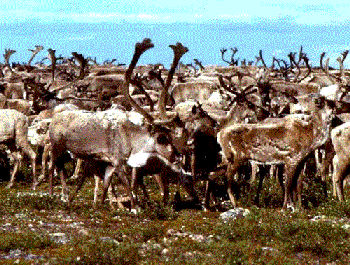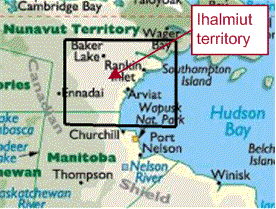- The Ihalmiut -->
- Back to Landing strip
At the margin
That part of the American continent now encompassing the U.S.A and Canada is divided into nine biotic provinces, each with its own environment. The two most northerly provinces are called, not surprisingly, Arctic and Tundra.
Spreading across the frontier of these two provinces is an area that was called by Samuel Hearne, the first white man to see it, the barrengrounds. It is an inhospitable region, criss-crossed by thousands of rivers and dotted with thousands of lakes, from small streams and ponds to massive waterways like the Great Slave lake and the Coppermine river. The land separating the water consists of bare rock outcrops interspersed with moss covered marsh.
This type of ground, the margin between the frozen north and tillable land, stretches in a wide band around the Earth. The surface soil is, at its deepest, only some 200 millimetres thick, below which is some thirty metres of permanent frost. During the last ice age, the ice on top of the tundra was some one mile thick and the scars left by the enormous pressure of this ice are still visible today.
On this tundra is where the Ihalmiut race of inland Eskimos lived.
In winter time it is a truly desolate area, with temperatures as low as minus seventy degrees Fahrenheit, winds of blizzard force, and not a tree in sight to relieve the monotony of the landscape. This winter of perpetual twilight lasts for some eight months of the year, but during the short summer season a complete transformation comes over the land. The snow disappears and the brown-green moss is dotted with tiny arctic flowers, stands of tall grasses and dwarf birch scrubs.
In summer, the Canadian tundra hosts a great variety of birds and animals; Curlews, Ravens, Yellow billed Loons and all manner of waterfowl inhabit the streams and stunted trees. Ground Squirrels, Foxes, Lemmings, Musk Oxen, Wolves, Grizzly bear and thousands of small mice roam the open spaces in temperatures sometimes getting on for ninety degrees in the shade.

There is one other animal on the tundra that was vital to the survival of the Ihalmiut in that inhospitable place, the largest and, until recently, the most populace of all Canadian mammals, Tuktu, the deer. Tuktu, called Caribou in North America, is a reindeer and they can be found all round the northern latitudes.
Tuktu provided food and shelter and its annual migrations determined where the Ihalmiut settled. The Ihalmiut really were people of the deer.

It is not altogether clear to me that we know the location of the main Ihalmiut camps, but somewhere to the west of Hudson bay is where the remnants ended up.
Last updated 1 January 2009